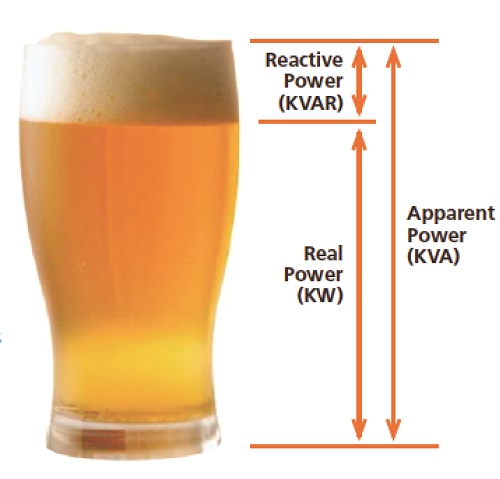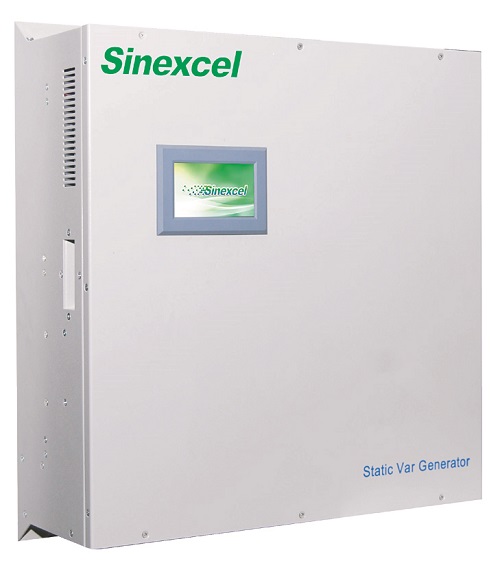What is power factor?
Power factor is an expression of energy efficiency and is a measure of how effectively incoming power is used in your electrical system. It expresses the ratio of real power actually used in a circuit to the apparent power delivered to the circuit and is usually expressed as a number between 0 and 1. For example, a power factor of 0.8 means that your installation is using 80% of the power being supplied to it. The higher the power factor the more efficient your site is at utilising the supplied power.
It’s important because you may be paying for power that you cannot use to power your equipment. Improving your power factor results in less current being drawn, less heat and greater longevity of your electrical system. Improving your power factor may also result in significant savings on your electricity costs.

Saving Money by improving power factor
Improving your power factor can result in considerable savings on your power bills. For example, think of a glass of beer, made up of the thirst-quenching liquid and the froth.
The drinkable liquid represents Real Power, the power that performs the actual work. Think of this as the satisfying liquid in the beer you’ve paid good money to drink. The froth represents Reactive Power, the power that energises your equipment. It doesn't do any useful work – it doesn’t quench your thirst.
As you pay for the whole glass of beer, you want more of the liquid and less of the froth to get value for money. Poor power factor is like a beer with too much froth, with the froth representing wasted energy (money). By improving your power factor, most or all of the power supplied that you are paying for is being used for productive work. By not paying for the froth, you save money.

HOW CAN I IMPROVE MY POWER FACTOR?
If you have poor Power Factor and have a kVA Max (Peak) Demand Tariff on your electricity bill, you can potentially save money from your electricity costs by improving your Power Factor. Poor Power Factor can be improved by installing Power Factor Correction (PFC) equipment.
Fuseco can assist you with Power Factor Correction options and help you to decide which solutions will benefit you.

THE SINEXCEL SVG
Simple power factor correction solutions incorporate banks of capacitors that work as silent reactive power ‘generators’. These systems were designed many decades ago when electrical environments were a lot simpler than they are today. They are common, very economical and suitable for linear load environments.
However, in today’s modern electrical environments, linear loads are not easy to find. Due to the proliferation of LED/energy efficient lighting, switch-mode power supplies, VSD’s, UPS’s, servers/computers and typical appliances, today’s electrical systems experience complex, dynamic non-linear loads. Loads are being switched so fast that the traditional capacitor bank PFC systems struggle to maintain an effective compensation set-point. Therefore, they are perpetually ‘chasing’ the load, either under or over-compensating but rarely providing effective compensation.
Fuseco offers the latest generation of advanced performance PFC solutions that offer instantaneous, dynamic step-less compensation, ideal for the challenging demands of modern electrical environments. The Sinexcel SVG solutions do not need a capacitor bank and offer many advantages due to their compact & modular configuration (including wall-mount options).
Benefits
Save money on electricity costs
If your billing has changed to a kVA demand tariff and you have poor power factor, you are definitely paying for electricity that you are not using. In such cases, the SVG will reduce your electricity bills. Typically, most installations achieve savings of 10%-30%.
Eliminating the weakest link – the capacitors
The most vulnerable and weakest link in a traditional PFC system are the switched capacitors. Capacitors can leak, rupture or ignite & have life expectancy of 3-7 years, depending on environmental conditions, resulting in high maintenance costs. The SVG eliminates the need for capacitors, resulting in greater longevity and minimal maintenance costs.
ROI (Return on Investment)
It makes great financial sense to invest in SVG technology. Typically, our customers achieve a ROI of 6 months – 2 years. After this period, they benefit from on-going cheaper electricity costs permanently.
Reduced burden on infrastructure
The SVG reduces heat on the electrical system, resulting in greater longevity and lower maintenance costs.
Can work with & enhance existing capacitor bank systems
If you already have an existing capacitor bank PFC system, you can add an SVG to improve the performance achieved.
Features
Exceptional power factor correction performance
Can maintain a Power Factor of 0.99 lagging or unity if required.
Dynamic step-less compensation
The Sinexcel SVG profiles the load and operates with a response speed of <15ms (Dynamic reaction time is less than 50us). It is a virtual real-time instantaneous response and it only injects the kVAr that is required in that moment. Therefore, the SVG is never over-compensating or under-compensating.
Corrects lagging (inductive loads) AND leading (capacitive loads)
Power factor range (-1 to +1)
Not affected by resonance
Can operate at low voltages
Wall-Mount Solutions
50kVAr
500W x 190D x 585H (mm)
Weight: 28kg
100kVAr
500W x 286D x 557H (mm)
Weight: 44kg
200kVAr
500W x 370D x 722H (mm)
Weight: 110kg



Rack & Cabinet Solutions
50kVAr
500W x 600D x 190H (mm)
Weight: 28kg
100kVAr
500W x 560D x 269H (mm)
Weight: 44kg
100kVAr (PRO Series)
530W x 550D x 190H (mm)
Weight: 35kg
200kVAr
500W x 722D x 370H (mm)
Weight: 110kg
Cabinets
Up to 500kVAr
Standard Flexi-Cabinet
800W x 800D x 2200H (mm)
Up to 600kVAr
Large Flexi-Cabinet
800W x 1000D x 2200H (mm)
SWITCHED CAPACITOR BANK SYSTEMS vs SINEXCEL SVG
PERFORMANCE CHARACTERISTIC | SWITCHED CAPACITOR BANK SYSTEMS | SINEXCEL SVG (Static VAR Generator) |
|---|---|---|
| Mode of Operation | The system detects the load current on a real-time basis through an external CT and determines the reactive content of the load current. The data is analysed and the system’s controller switches in the required amount of reactive current in steps, depending on the amount of reactive current available to it in that moment from the capacitor bank. | The SVG detects the load current on a real-time basis through an external CT and determines the reactive content of the load current. The data is analysed and the SVG’s controller drives the internal IGBT’s by using PWM signals to make the inverter produce the exact reverse reactive current of the corresponding load reactive current. |
| Compensation method | Traditional PFC systems use capacitors in groups. Their output current is in fixed steps (50kVAr, 25kVAr, 12.5kVAr, 6.25kVAr) which usually leads to over or under-compensation. | The SVG performs as a controlled current source, thus obtaining a power factor of 0.99 lagging whilst avoiding over-compensation and under-compensation. |
| Response Time | Capacitor bank style PFC systems take at least 20ms – 40s to perform compensation depending upon whether the switching is done via a solid state switch or a contactor. | The complete response time of the SVG is less than 15ms and the dynamic response time is less than 50μs. The SVG can track the dynamics of the load and compensate instantaneously in almost real-time. |
| 3 Phase Operation | A switched capacitor bank style PFC system measures only one phase and provides stepped kVAr compensation only to that phase, irrespective of what the other two phases need. | The Sinexcel SVG measures and provides dynamic kVAr compensation throughout all three phases. |
| Load Imbalances | Capacitor banks with Delta connected capacitors cannot balance the load currents in a three phase system. | The Sinexcel SVG can, if required, balance the phase currents to further lower the peak kVA presented to the grid (or energy authority). |
| Resonance | Traditional PFC systems are affected by resonance, which is detrimental to the capacitors. To lower the risk, de-tuning reactors are introduced into the circuit to lower the resonant frequency below that of the lowest harmonic in the circuit. | The capacitance of the SVG does not require the installation of a de-tuning reactor. Performing as a current source and an active compensation device the SVG has been designed to not be affected by resonance. |
| Harmonics | Even with the use of de-tuned reactors, harmonics play a major role in shortening the lifespan of capacitors and contributing to their destruction. | The Sinexcel SVG can operate in harmonically rich environments of up to 15% THDV without detriment to itself or its performance. |
| Load Type | Capacitor bank style PFC systems can only compensate for inductive loads. | The SVG can correct both a lagging and a leading power factor, as well as work with a traditional capacitor type PFC system to eliminate over and under compensation. |
| Operation at low voltages | Capacitor output is subject to the voltage of the grid, so if the grid voltage is low the output of the capacitors will be low, resulting in a decline in available compensating capacity, under-compensation and possible fault conditions. | Designed with an active compensation circuit. Therefore the voltage of the grid has little influence on the compensation capacity. The output of reactive current matches the working conditions even when the voltage of the power grid is low. |
| Sizing | To better suit the changing dynamics of the load, a traditional capacitor type PFC system needs to be oversized and to have a greater number of smaller steps to better suit the application. This increases the cost. | The compensation capacity of the SVG is the same as the installed capacity. Therefore for a given compensation effect, the capacity of the SVG may be 20%-30% less than that of a standard capacitor type PFC system. |
ROI (Return on Investment) | When estimating the ROI for capacitor bank style PFC systems, apart from the initial cost of the system, other factors over the medium to long term must be considered, including the on-going cost of the maintenance contract and replacement parts like the capacitors, contactors, fuses, etc. | The SVG does not require a maintenance contract. It simply requires that the unit is kept clean. Aside from the initial purchase cost, on-going costs are negligible. |
SUITABLE TECHNOLOGIES FOR DIFFERENT APPLICATIONS
Switched capacitor bank style PFC systems are economical and effective in the following applications:
- Electrical environments with stable linear loads. (eg. Direct-on-line electric motors).
Sinexcel SVG PFC systems are economical and effective in the following applications:
- Ideal for fast switching load environments (switched capacitor bank system can’t keep up).
- Environments with space restrictions. Wall mounting solutions save valuable floor space -single modules are available up to 200kVAr and can be parallel connected. Single cabinet solutions up to 600kVAr are available.
- Electrical systems with leading power factor loads (eg. data centres).
- Unbalanced load environments. SVG's correct load imbalances.
- Low voltage environments (eg. country or remote areas, mining locations).
- Harmonically rich environments, possibly with resonance issues (eg. VSD’s, LED lighting, data centres).
Technical Support
Our experts are all pre-eminent leaders in electrical products who provide excellent support in their areas of expertise.
Technical supportTalk to an expert
Our friendly team are highly trained product experts who really enjoy helping customers find what they need.
call 1300 387 326Enquire by email
We promise to respond within 4 business hours (AEST) or you will receive $100 off your next purchase.
Enquire now